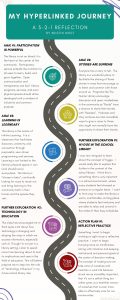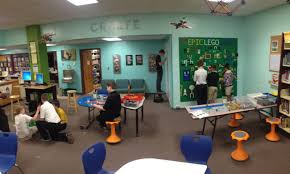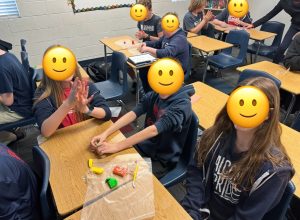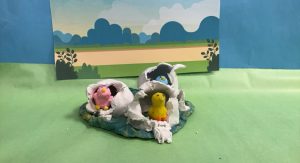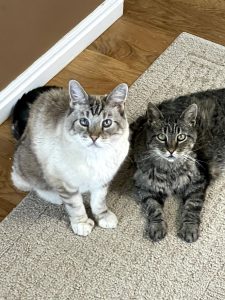Assignment X: Participatory Service in the Middle School Library

*For full size graphic, please click here
Introduction
As a middle school teacher, I have noticed that teachers and students seem to utilize our school library very little. As my own path will likely lead to the school library, this has led me to ponder: “How can we make students and staff feel enthusiastic about coming to the library?” “How can we improve services so that each user feels the library has value to them on an individual level?” The concept of “Participatory Service” in Module 4 resonated with me as there are so many fantastic ways to encourage participation from everyone in the community, giving users a sense of ownership in the library and fostering excitement in being connected with what the library has to offer. It’s important to keep in mind that “participation requires engaged participants who feel welcome, comfortable, and valued” (Stephens, 2016, p. 81). Of all the changes discussed in “Redesigning Library Services: A Manifesto” (Module 1), I believe one of the most important ones is shifting “from a library-centered world view to one that is user-centered” (Buckland, 1992). Herein lies the opportunity to truly transform a school library from a static and isolated entity into the dynamic, beating heart of the school with the power to bring people together in powerful ways.
Connections with Staff Users
Something that struck me from @michael‘s Hyperlinked Library Model lecture is the concept of a “silo”: a person or department keeping their knowledge and expertise to themselves rather than connecting and sharing with others (Stephens, 2019). I have certainly seen school librarians who stay in their domain and rarely make efforts to reach out to others. They are usually happy to help anyone who comes to them directly, but have shown little desire to reach out and connect with other staff members to collaborate and brainstorm. I loved reading in Module 3 about the librarians who regularly meet with groups of teachers to plan assignments together, thus increasing faculty buy-in at the library (Mathews, 2010). In my experience, teachers often make little use of the library simply because they aren’t aware of what it has to offer, or are hesitant to “bother” the librarian by asking for assistance with something they’re teaching. By taking down the proverbial silo and reaching out to teachers in an expression of camaraderie, barriers to staff utilization of the library can come down as well.
Connections with Student Users
It is essential to give students ways to communicate and share their thoughts and ideas in order to give them ownership in their library. There are virtually limitless ways to foster this connection. One idea that @michael mentioned in his Participatory Service lecture that I loved was the “Tell Us What Makes You Happy at the Library” wall. This would provide a fantastic opportunity to see what students are enjoying so that these services or practices can continue to be offered or expanded. Other students could see how their peers are interacting with the library, leading to increased awareness of resources and services. Another way to utilize this concept, would be to have a digital version, where students could scan a QR code to add to a virtual comment board to be displayed on a TV screen. I can picture this being especially effective if placed outside the library in the hallway, where those who use the library less often may have their interest sparked as they read the comments from their peers.
In planning for new services, resources, or programming, librarians could give students the chance to (anonymously if they wish) share ideas on an online platform for the new things they would love to see or experience in the library.
Inspiration from a Stellar School Library
Recently, the Scotts Ridge Middle School library in Ridgefield, CT was named “Library of the Year” by the AASL (Fox, 2025), and the reasons for this distinction are tied into their exemplary participatory service. Their teachers feel welcome to discuss their ideas with librarians and brainstorm together, thus keeping the library directly involved with what is happening in the classroom. A recent collaboration between librarians and teachers resulted in interactive collages (in French!) that were written, designed, and recorded by students. The library also boasts a maker space where students can record podcasts, and a “Read and Ride” area where students can ride a stationary bike while reading (it’s unclear if this idea came from the students or was simply inspired by an observation of their needs, but what an amazing way to reach students who benefit so much from being able to move throughout the day)!
Podcasting!
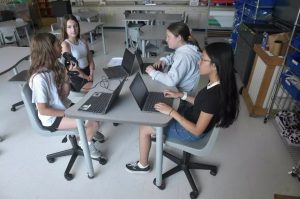
(Fox, 2025)
Read and Ride:
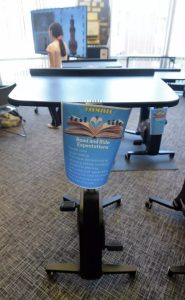
(Fox, 2025)
Reflection/Conclusion
It’s exciting to think about the many ways school librarians can connect staff and students to the library. The goal is for all users to be able to feel that the library is truly THEIRS, that it’s not just “a place to go check out a book you need” but exists to enrich their lives in exciting ways and foster valuable connections with people and information. To me, the concept of Participatory Service provides the pathway to reaching that goal, and it is something to keep at the center of our thought processes as we continue to find ways to shift from a materials-centered world view to one that is truly user-centered.
References
Buckland, M. (1992). Redesigning library services: A manifesto. American Library Association. https://digitalassets.lib.berkeley.edu/sunsite/Redesigning%20Library%20Services_%20A%20Manifesto%20(HTML).pdf
Fox, S.D. (2025, June 18). Library at Scotts Ridge Middle School in Ridgefield earns national honor: ‘Vibrant hub’ for learning. ctpost. https://www.ctpost.com/news/ridgefield/article/ridgefield-school-library-national-scotts-ridge-ct-20360563.php
Mathews, B. (2010, June 21). Unquiet library has high-schoolers geeked. American Libraries. https://americanlibrariesmagazine.org/2010/06/21/unquiet-library-has-high-schoolers-geeked/
Stephens, M. T. (2016). The heart of librarianship : attentive, positive, and purposeful change. ALA Editions, an imprint of the American Library Association.
Stephens, M.T. (2019). “Historic” hyperlinked library model. [Lecture recording]. Panopto. https://sjsu-ischool.hosted.panopto.com/Panopto/Pages/Viewer.aspx?id=a0569381-4d66-4e0a-a7fa-aab3010a8f3e
Stephens, M.T. (2025). Hyperlinked library participatory service and transparency. [Lecture recording]. Panopto. https://sjsu-ischool.hosted.panopto.com/Panopto/Pages/Viewer.aspx?id=2a19a4b6-e945-4d2e-abf1-aef3014172a5
